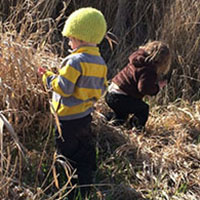— from Ryan Weisberg, Lead Teacher, Orcas Island Forest School ( all photos by Ryan Weisberg)–
[metaslider id=42501]
Early in the school year we (children and teachers) spent a lot of time trying to figure out who we were and where we were—we learned about one another’s personalities and interests, we were focused on making friends, and we were just beginning to discover and experience what the forest had to offer. We hadn’t yet discovered our sense of place.
Early in February we began the process of making forest tea. The weather we experienced throughout the month ranged from cold rain to warm sunshine and everything in between, and warm tea was a ritual we could enjoy whatever the weather.
Although we’ve been talking about the trees and plants in our forest since September, Kimberly and I made sure the children could identify what was edible and what was not. We’ve been adding varying amounts of cedar “leaves” (actually called “scales”) hemlock needles, fir needles, pine needles, Salal leaves, Oregon Grape root, and at the end of the month some Oregon Grape flowers that had just started to open. More recently we’ve been adding flowers blown down from high up in Bigleaf maple trees, and have noticed Stinging Nettle leaves and Sword fern fiddleheads, which can both be added to the tea.
Tree Identification:
- Douglas fir: Thick, grooved bark. Green needles that come out on all sides of the branch and are all the same length.
- Western Redcedar: Bark that looks striped and peels off in long strips. Flat, green “scales” (not quite needles or leaves).
- Western Hemlock: Smallish chunky bark. Flat green needles of different lengths.
- Pine: Long needles that grow in groupings of two or more.
As the children have developed a more intimate relationship with the forest, they have discovered new uses for familiar objects, one day using a stick and a big rock to create a teeter totter. We’ve built towers and houses with wobbly wooden blocks. And we’ve created bakeries and kitchens full of cookies, cakes, and other delicious food made from mud, dirt, and a sprinkling of green needles from nearby trees.
With the input of early spring energy we have explored new areas of the meadow that sits just outside the forest. We discovered a pond, soggy green grass, and whispering brown grass that stands taller than the children.
Birds we’ve encountered this month:
- Canada Goose
- Pacific Wren
- American Robin
- Redwing Blackbird
- Woodpeckers
- Barred Owl
- Ducks
Comparing September and October with February and March, it’s obvious that we (again, children and teachers) have developed much deeper relationships with both the forest and with each other. Six months into the school year our collective knowledge about this place has grown exponentially. We’ve seen the landscape change from late summer, to fall, to winter, and now into early spring. The children have learned about this place through discovery, trial and error, and experiencing everything from being wet and cold to being hot and sweaty—and having fun the whole time.
Upcoming Orcas Island Forest School Events:
Come learn about our school and meet teachers, board members, and parents of current Forest School kids: presentations at the co-op March 23, 3-5pm and April 5, 5-7pm.
Check out our “classroom” and meet teachers, board members, and parents of current Forest School kids at our Open Forest on April 6, 3-5pm.
Interested in getting your child involved in Forest School? Our 8-week Spring Session begins April 25!
For registration and other information, please email oiforestschool@gmail.com and check out our website: orcasislandforestschool.org








